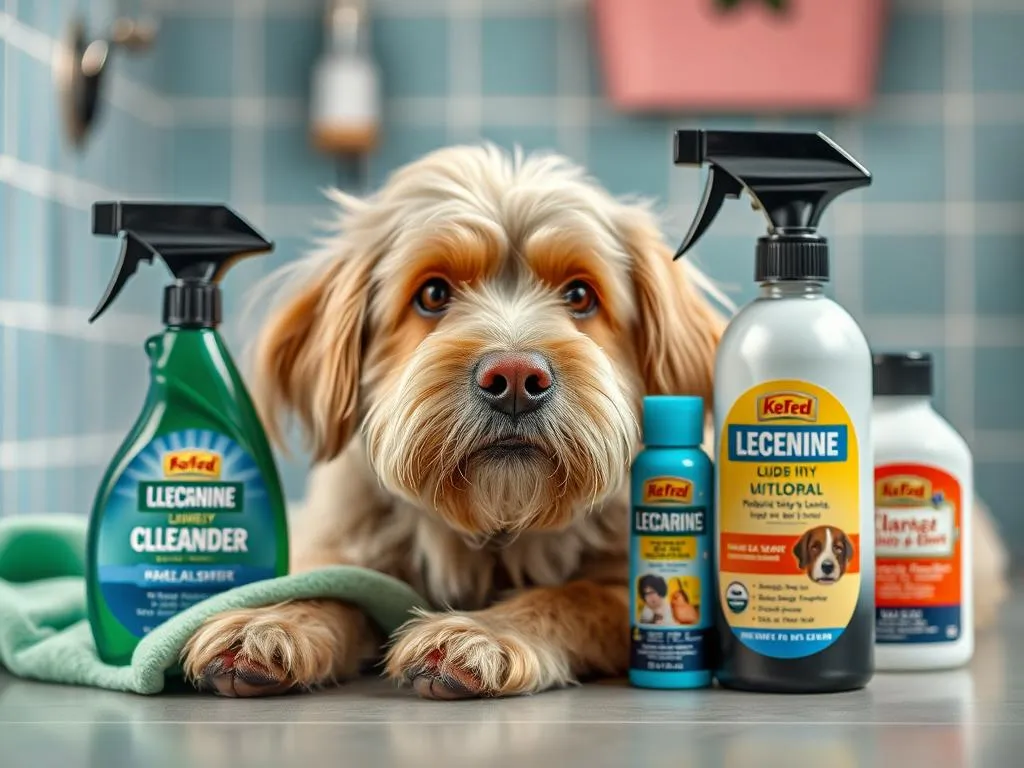
Introduction
When it comes to maintaining a healthy environment for our furry companions, the significance of dog health care cannot be overstated. Our homes should be a sanctuary for our dogs, yet many pet owners unknowingly expose their pets to harmful substances lurking within common cleaning products that are not dog safe. Statistics reveal that a significant number of pet health issues are linked to toxic exposure, making it imperative for dog owners to understand the interplay between household cleaning practices and their pets’ well-being.
As we delve into this topic, the aim is to arm dog owners, potential adopters, and pet care professionals with knowledge about harmful cleaning products and to encourage safe cleaning practices. By understanding what ingredients to avoid and how to create a dog-friendly home, we can minimize risks and enhance our pets’ quality of life.
Understanding Dog Health and Safety
Common Health Issues in Dogs
Dogs, like humans, are susceptible to various health problems, many of which can be exacerbated by their living environments. Common issues include:
- Allergies: Dogs can develop allergies to a range of substances, including certain chemicals in cleaning products. Symptoms may include itching, sneezing, and skin irritations.
- Toxic Exposure: Many cleaning products contain toxic substances that can lead to poisoning. Dogs are particularly vulnerable as they tend to explore their surroundings with their mouths.
- Digestive Problems: Ingestion of harmful cleaning agents can lead to severe digestive issues, including vomiting and diarrhea.
Importance of a Safe Living Environment
Maintaining a clean home is essential for preventing health problems in dogs. However, the types of cleaning products used can significantly influence this outcome. A safe environment not only protects dogs from physical ailments but also plays a role in their behavior and overall well-being. Clean environments can reduce stress and anxiety in pets, making them feel more secure and comfortable.
Overview of Cleaning Products
Types of Cleaning Products Used in Households
In our quest for cleanliness, many products become staples in our households. Some common types include:
- Surface Cleaners: Used to wipe down countertops, tables, and other surfaces.
- Disinfectants: Often employed to kill bacteria and viruses, these can be particularly potent.
- Floor Cleaning Solutions: Used for mopping and maintaining flooring surfaces.
- Laundry Detergents: Essential for cleaning pet bedding and clothing, but they can contain harmful ingredients.
Ingredients in Cleaning Products
Understanding the ingredients in these cleaning products is crucial. Many household cleaners contain harsh chemicals that can be detrimental to dog health. Some common chemicals include:
- Sodium hypochlorite (bleach): A strong disinfectant that can cause respiratory issues and skin irritation.
- Ammonia: Often found in glass cleaners, it can lead to severe eye and skin irritation.
- Phthalates: Used to make fragrances last longer, these chemicals are linked to hormonal disruptions.
- Hydrogen peroxide: While it has some safe uses, high concentrations can be toxic to dogs.
Identifying Unsafe Cleaning Products
Key Ingredients to Avoid
Dog owners should be vigilant about avoiding cleaning products that contain the following harmful ingredients:
- Bleach: While effective in killing germs, bleach can cause respiratory problems and skin burns.
- Ammonia: Its strong odor can be harmful, leading to irritation of the eyes and respiratory tract.
- Phthalates: Often used in fragrances, they can disrupt hormonal balance and have been linked to reproductive problems.
- Hydrogen peroxide: Concentrated forms can be dangerous, causing burns and gastrointestinal distress if ingested.
Commercial Products Known to be Dog Unsafe
Here are some popular cleaning products known to pose risks to dogs:
- Clorox Disinfecting Wipes: While convenient, they contain bleach and other harmful substances.
- Mr. Clean Multi-Surface Cleaner: Contains ammonia, which can irritate your dog’s respiratory system.
- Febreze Air Effects: Contains phthalates and artificial fragrances that can cause allergic reactions.
Testimonials from affected dog owners often highlight the dire consequences of using such products. For instance, a dog owner shared a harrowing experience where their pet suffered from severe respiratory distress after cleaning the floors with a commercial disinfectant.
Signs of Toxic Exposure in Dogs
Physical Symptoms to Watch For
Understanding the signs of toxic exposure can save your dog’s life. Watch for these physical symptoms:
- Vomiting: A common reaction to ingesting harmful substances.
- Diarrhea: Often accompanies vomiting and indicates gastrointestinal upset.
- Skin Irritation: Redness, itching, or swelling can signal a reaction to chemicals.
- Behavioral Changes: Lethargy, aggression, or unusual hiding behavior can be indicators of distress.
When to Seek Veterinary Care
If you suspect your dog has been exposed to a toxic cleaning product, immediate action is crucial. Here are guidelines to follow:
- Identify the Product: Keep the product label handy; it contains vital information for your vet.
- Monitor Symptoms: Take note of any symptoms and their severity.
- Contact Your Veterinarian: Always err on the side of caution. If symptoms are severe, visit the vet immediately.
- Provide Information: When you reach the vet, provide as much information as possible about the product and your dog’s symptoms.
Keeping a list of harmful products in your home can facilitate quicker responses during emergencies.
Safe Cleaning Alternatives
DIY Cleaning Solutions
Creating your own cleaning solutions can be a safe and effective alternative. Here are a few recipes using safe ingredients:
- Vinegar and Water Solution: Mix equal parts white vinegar and water for a natural surface cleaner.
- Baking Soda Scrub: Combine baking soda with a little water to create a paste for scrubbing surfaces.
- Lemon Juice Cleaner: Mix lemon juice with water to create a fresh-smelling disinfectant.
Using natural cleaners not only protects your dog but also benefits your household’s overall health.
Recommended Pet-Safe Commercial Products
For those who prefer store-bought alternatives, here are some brands that offer dog-safe cleaning products:
- Seventh Generation: Known for its eco-friendly cleaning solutions, free from harmful chemicals.
- Method: Offers a range of plant-based cleaning products that are safe for pets.
- Ecover: Focuses on biodegradable ingredients and is safe for homes with pets.
When selecting cleaning products, always read labels and look for safety certifications to ensure they are free from harmful chemicals.
Best Practices for Dog Owners
Creating a Dog-Safe Cleaning Routine
Establishing a cleaning routine that prioritizes your dog’s safety is essential. Here are some steps to follow:
- Choose Safe Products: Opt for DIY solutions or pet-safe commercial products.
- Ventilate: Ensure your home is well-ventilated while cleaning to reduce the concentration of any potentially harmful fumes.
- Timing: Clean when your dog is outside or in a different room to minimize exposure.
- Storage: Store all cleaning products out of reach of pets to prevent accidental ingestion.
Education and Awareness
Ongoing education about safe cleaning practices can foster a community of informed pet owners. Sharing experiences and knowledge can lead to better safety practices. Consider joining local pet owner groups or online forums to discuss safe cleaning methods and learn from others.
Conclusion
In summary, maintaining a healthy home for our dogs requires careful consideration of the cleaning products we use. By avoiding harmful chemicals often found in cleaning products that are not dog safe, we can significantly reduce the risk of health issues for our furry friends. Understanding the symptoms of toxic exposure and creating a dog-safe cleaning routine are essential steps in promoting a healthy environment.
As responsible dog owners, it’s our duty to protect our pets from potential hazards. Implementing safe cleaning practices not only enhances our pets’ quality of life but also fosters a loving and secure home. Let’s commit to making informed decisions that prioritize our dogs’ health and well-being.









